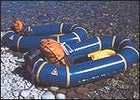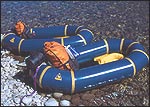So, just what are you saying? That you’re a gaggle of portly fellows? And the idea is to lug in an inflatable raft or kayak, then paddle to remote parts of the lake?
 Yukon Yak/Denali Llama
Yukon Yak/Denali Llama
Well, I must admit: Ingenious. Perhaps insane as well, but who am I to judge?
On the Sevylor side, I assume the raft you found is the HF160 Fish Hunter, which sells for $60 and weighs just under three pounds without paddles and the like (www.sevylor.com). Rated capacity is 220 pounds, so even I—a svelte 160-pounder—could come close to topping out in it with a big pack. But while I’m not going to suggest before the world that you can safely overload it by 40 or 50 pounds, I think it reasonable to assume that the raft is not going to suddenly pull a Titanic on you if the load happens to be 221 pounds, if you get my drift.
How durable is the Fish Hunter? Well, it’s an inexpensive, lightweight raft, strictly for calm lake water. It’ll be OK for your purposes, but be sure you have supplies for repair. And you might find it a real brute to paddle—it’s really more for just bobbing around. You know the terrain, but I’m not sure the savings here justify employing what’s essentially a recreational craft into a vehicle for demanding wilderness travel.
The Alpacka rafts are much more serious devices from a company based just outside of Anchorage, Alaska—so let’s assume they know wilderness. That company’s Yukon Yak, for instance, is a mid-sized raft that can easily support you and your pack. And, it’s very ruggedly built of a very sturdy coated nylon yet still weighs only four pounds. People have run Class III and IV rapids in these things. But as you note, price is an issue. The Yukon Yak or the slightly larger Denali Llama both sell for $595 (www.alpackaraft.com). Obviously, an Alpacka Raft is a craft meant to be a long-term investment that will receive considerable use. I also think it will row better than the less-rigid Sevylor. But it’s your money, so you’ll have to make a decision based on what you can afford. For what it’s worth, the Alpacka people got into the business exactly for the uses you describe (as well as to equip wilderness racers); Sevylor specializes more in the generic fun-boat aspect.
In any event, give serious thought to adding a PFD to your load, just in case you end up swimming.


